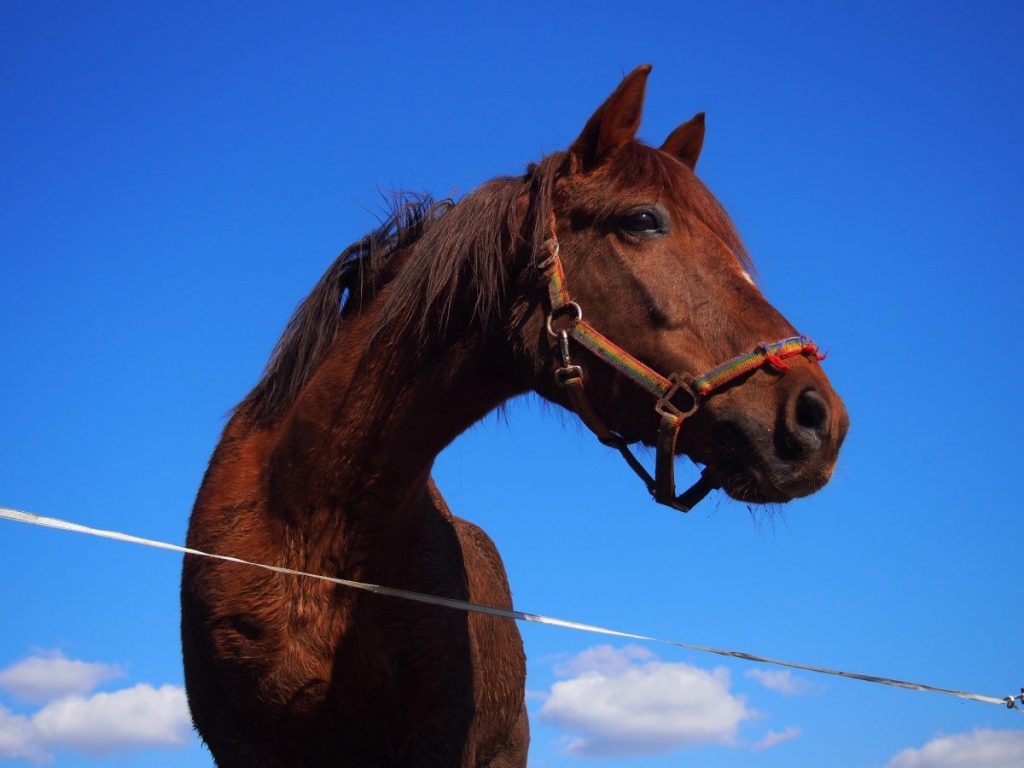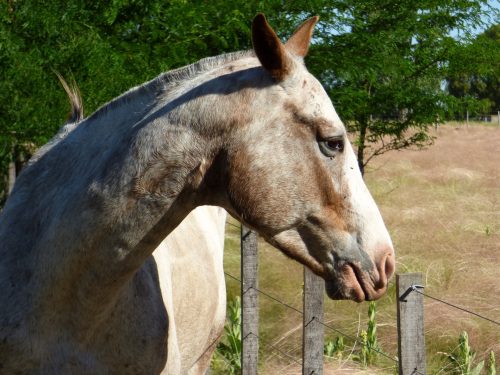Laminitis is an extremely painful and potentially crippling disease affecting horses that can even be fatal. If the disease has progressed to the point that it would be inhumane to continue treatment, the horse will have to be euthanized. It does not always get this serious, and catching laminitis early can make sure things never get to this point. But in order to do so, you’ll need to be able to understand what laminitis is.
How does laminitis affect horses?
Literally, laminitis means an inflammation of the insensitive and sensitive laminae in a horse’s foot. The laminae are the tissues that are located between a horse’s hoof wall and coffin bone. These tiny, finger-like structures interlock and secure the coffin bone to the hoof wall, keeping the bone in place.
A horse’s hoof wall has an interlinked outer insensitive layer (horn) which is supported by an underlying inner sensitive layer (laminae). The laminae support the pedal bone in the hoof and are responsible for supporting the weight of the horse.
Healthy horses have steady blood flow to their feet, but in horses with laminitis, the blood flow to the laminae is disrupted. This can result in inflammation and swelling in the tissues within the hoof, which can weaken the laminae and cause severe pain. The cells become damaged as well because the laminae are starved of oxygen and nutrient rich blood. The bone bond in the hoof wall will weaken and become unable to hold the coffin bone in place.
The sensitive laminae will start to die unless the cause of the laminitis is identified and removed right away by treatment. But then the question becomes: how do you identify the cause?
Laminitis can affect any of a horse’s four feet but is most commonly seen in the front feet. Any horse of any age can be affected by the disease. There are several tell-tale signs of laminitis that you should be able to identify. These can include changes in how the horse walks and stands to its overall disposition. Knowing your horse well can go a long way to identifying when something is wrong.
What Causes Laminitis in Horses?
Naturally, there are many possible causes of laminitis in horses, but as mentioned above, properly identifying the source is the first step to recovery. Several factors can also predispose a horse to developing laminitis, such as being overweight, or especially those horses that have had laminitis previously. Let’s go over some of the many causes of this disease.
Nutrition-induced laminitis
A high intake of soluble carbohydrates can be a cause of laminitis. This is also known as carbohydrate overload. Soluble carbohydrates, including sugars and starch, when consumed in excess, can overload the horse’s digestive system with undigested sugar and starch, which is pushed through to the hindgut.
When bacteria try to break down this undigested material, it will cause acidity, which destroys the bacteria that help to digest fiber. When these bacteria die, they release toxins into the gut. These toxins then pass into the bloodstream through the gut wall and provoke a response within the horse that can disrupt blood flow. If this process occurs in the feet, it can cause laminitis.
Horses are designed to digest carbs, but when the small intestine’s capacity is overloaded by too much intake, they flow to the hindgut, causing the acidity. This toxic environment in the bloodstream can make a horse prone to laminitis.
Horse feeds that are rich in carbohydrates are very energy dense. This means a horse can consume more carbs than his body can handle, so it is imperative that you limit his intake. Make sure you carefully measure your horse’s food quantity to feed him properly and avoid this condition.
Carbohydrates also fall into two categories: structural and non-structural.
Structural carbs are commonly known as fiber and are vital to a horse’s diet. The sugars and starches fall under non-structural carbs and are usually broken down by enzymes in a horse’s small intestine into glucose.
Non-structural carbohydrates that are commonly seen in a horse’s diet include cereal grains, such as oats, corn, barley and more, plus molasses and lush pasture (grass/hay). Other conditions, such as obesity, insulin resistance, Cushing’s disease and tying-up are also associated with excess non-structural carbohydrate overload.
Fructan is another type of carbohydrate that has received a lot of recent attention. Fructans are a combination of fructose and glucose. Short fructans are known as oligosaccharides. Horses don’t have the enzymes needed to break fructans down, so the hindgut bacteria is needed to do it.
If too many fructans are consumed, it could cause laminitis and other conditions. Fructan levels in pasture grass can actually change throughout the day, seeing their highest levels in the late afternoon in mild climates. They are also high in mornings after a frost. To help limit this risk, reduce your horse’s turnout time during spring and autumn and after a morning frost.
Stress
Just like in humans, stress can be a major health factor for horses. Any life events that can cause your horse to become stressed, such as dramatic changes to the horse’s environment or frequent travel, put a horse at risk to develop laminitis and other health conditions. This is especially true for overweight horses and mares that have just given birth, because of the added physical stress.
Stress can also be caused by overworking an unfit horse, overwork or prolonged travel in hot or cold conditions, medications, vaccinations and more. Any stress trigger for your horse should be avoided.
Severe infection
Systemic diseases that have a septic or toxic focus can cause laminitis. This includes pneumonia, pleurisy, diarrhea, colic, and purulent metritis. Blood poisoning, or toxaemia, can also be a cause. When these conditions cause laminitis, the initiating cause must be identified and treated before you can turn your attention to the laminitis.
Bacterial infections, plant, chemical and fungal toxins, viral infections, severe colic attack and prolonged diarrhea can all be underlying causes that need to be addressed before the laminitis can be treated.
Obesity or overeating
Obesity is actually one of the most common causes of laminitis, formally called Obesity Dependent Laminitis (ODL). Be careful not to overfeed your horse. Horses can put on weight quickly when they are consuming more calories than they are able to burn off. And it can sometimes be easy to go blind to it as the horse’s owner.
Obesity has plenty of poor effects on a horse’s health, with laminitis among them. The added weight puts excess stress on the horse’s organs as well as his limbs. This can cause abnormal growth patterns in the hooves and even start to break them down. Horses can easily become obese if allowed to graze fertilized cattle pasture. Native horses actually require very little to eat.
While human obesity gets plenty of attention in the media, pet obesity actually also has alarmingly high rates. Horses are much more susceptible to laminitis and insulin resistance when they are overweight. If you’re unsure about how much to feed your horse, seek the help of your veterinarian. This can go a long way to keeping your horse as healthy as possible.
Trauma or mechanical issues
Another potentially common cause of laminitis is trauma or mechanical issues to the horse. There are several ways a horse can encounter trauma that may cause laminitis. These include if a horse has been worked hard and fast on a hard surface for a prolonged period of time. Such as trotting on roads or jumping in the summer, having race horses on firm ground, or endurance horses that are inadequately fit.
Over-activity in these situations can put a horse at risk because it affects the laminae, most notably if the horse has poor quality hooves. Improper foot dressing can also cause laminitis to occur. Improper shoeing can cause sole pressure that can be another contributing factor. If lameness begins to set in, laminitis may be the underlying cause due to one of these situations.
Cushing’s Disease
Mentioned briefly above as a contributing factor with overconsumption of carbohydrates, Cushing’s disease can actually also be a cause of laminitis. Cushing’s disease is associated with an abnormality in the horse’s pituitary gland, which is found at the base of the horse’s brain.
When this occurs, the horse might become excessively thirsty or have an increased appetite. The horse may also sweat quite a lot and can even lose weight. Its coat may also become very curly. In addition to all of these symptoms, a horse may also develop laminitis from having Cushing’s disease.
Corticosteroids
Corticosteroid drugs can induce laminitis if they are given to anxious horses or horses that are susceptible to the disease. This will not happen every time the corticosteroids are used, but there is a risk that your veterinarian should make clear before prescribing them. When corticosteroids are the trigger for laminitis, the disease usually progresses rapidly to acute laminitis and can be an emergency situation.
Long-acting corticosteroids like triamcinolone and dexamethasone are particularly dangerous to the horse. Mixtures of drugs that have corticosteroids in them can also be dangerous and cause laminitis. Corticosteroid usage should be closely monitored by your veterinarian keeping laminitis in mind.
Hormonal causes
This most commonly affects older horses who develop neoplasia, but can be seen in younger horses as well. The neoplasia is usually seen in the pars intermedia of the pituitary gland. These horses will be unable to shed their coat in the spring, and the coat will then become long and fine, or even matted. These animals may also be diabetic, as laminitis is a common secondary infection. Thyroid function and pituitary neoplasia should both be tested in these cases.
Insulin resistance
Insulin is a hormone involved in the regulation of glucose (sugar) levels in the blood and tissues of the horse’s body. When a horse consumes food, insulin is secreted by the pancreas to the bloodstream. The insulin guides the glucose that is absorbed from the food into the body’s tissues, such as the liver, fat and muscle. When the insulin is not able to perform this function, there is an incidence of insulin resistance in the horse.
When a horse is insulin resistant, the glucose will enter the tissue at a much lower rate than normal. The lower intake rate into the tissues will result in higher levels of blood glucose, which causes the horse’s body to release more insulin in the bloodstream. This is a major contributing factor to the development of laminitis, but can be easily tested to see if it might be the cause.
The cause of a horse’s laminitis can often be difficult to pinpoint, but it can make the difference in whether or not the condition can be treated successfully. So make sure you’re paying attention to the signs and be intimately familiar with your horse so you can help diagnose the underlying cause and set your horse on the road to recovery.







